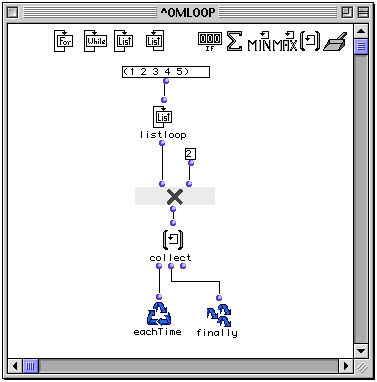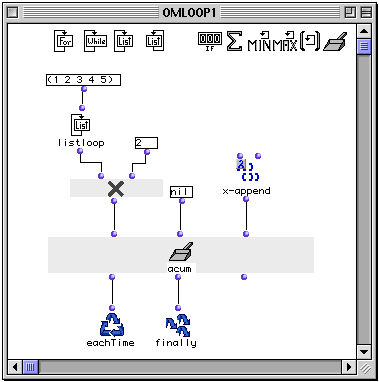OpenMusic Reference
listing

listing
(control module) -- returns the results of omloop in a list
Syntax
listing what? &optional retard
 |
Though it is called listing in its LISP code, this function appears as collect when used inside omloop . The reason eludes me.
—|—
Inputs
| name | data type(s) | comments |
|---|---|---|
| what? | any | |
| retard | a function name or lambda function |
Output
| output | data type(s) | comments |
|---|---|---|
| first | a list with one element | triggers the collection |
| second | a list or tree | returns the state of the collection without evaluation |
| third | 0 | reinitializes the counter, resetting it to nil |
Description
 |
listing is part of a group of functions for performing iterative loops. They can only be used within an omloop patch window. Since they only function within the context of the entire repeating loop, they (or any function connected to them) cannot be evaluated directly within the patch window. You must evaluate the entire loop. See the entry on omloop for more information.
—|—
listing is a type of collector. It returns all the results of the loop in a single list. If the results of the loop function are themselves lists, the result will be a tree.
Like all collectors, listing has three outputs:
The first output triggers the collector, evaluating whatever is connected to it and appending the result to the list of values of previous repetitions of the loop. It is usually connected to eachTime . The value carried by the connection itself is the current result of the evaluation of the loop, enclosed in parentheses, a list of one element. You can verify this by placing the lisp function print between the first output and eachTime .
The second output returns the current state of the collector, without evaluating whatever is connected to it. It is usually connected to finally so that you can get the results of the addition.
The third output reinitializes the collector, resetting it to nil. The value carried by the connection is always nil.
Examples
 |
About the collectors |
|---|---|
listing is a type of collector. The most generalized type of collector is the function accumulator . Some collectors are special versions of the accumulator function. In these cases, the example of the use of the specific collector is reproduced with accumulator to illustrate this. The reader is therefore advised to read the entry on accumulator before continuing.
Gathering the results of omloop using listing

This simple example takes each of the elements (1 2 3 4 5) and passes them individually to om* , where they are multiplied by 2 and passed to listing , which simply collects them into a list. The output is:
? OM->(2 4 6 8 10)
Reproducing listing with accumulator

We will set up accumulator to perform exactly the same function. The listloop output of (1 2 3 4 5) is run into the first input. We set the initial value to nil and connect the function x-append to the fun input. At each iteration, the list of stored values of the evaluations coming into the first input of accumulator and the current evaluation of the loop are passed to x-append . The resulting list is stored, for the next pass.
For a more musical example of the use of listing , see the entry for listloop .
| Prev | Home | Next |
|---|---|---|
| maxi (max) | Up | accumulator |